Throughout its proud history, the University of Illinois College of Veterinary Medicine has been grounded in science and inquiry into the workings of the body, committed to improving the health and welfare of animals and people, and united as a caring community.
Veterinary Education and Service before 1948
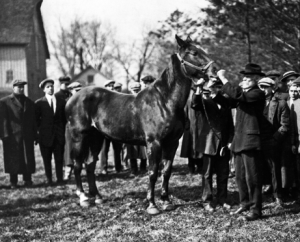
Veterinary service and education at the University of Illinois date to the early years of the university’s existence. A course in veterinary medicine and surgery was first offered in 1870, and weekly “horse clinics” became a staple of care for local owners in the late 1800s. In the early 20th century a busy veterinary diagnostic laboratory on the university campus met crucial needs in the state’s agricultural industries, along with livestock disease eradication programs led by university personnel.
Although a College of Veterinary Medicine was authorized by the state General Assembly in 1919, it was not until 1944, in response to growing demand from farmers and veterinarians, that the Board of Trustees formally established the college. The following year, in 1945, the Illinois legislature authorized funding to construct a basic science laboratory for the college, though the building was not completed until 1952.
Establishment of the College
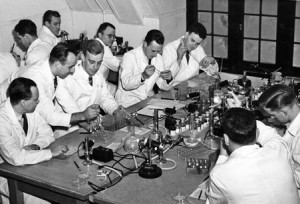
When the first class—twenty-four men, all of whom were World War II veterans—enrolled in 1948, lectures and labs took place in an old sorority house while kennels, large animal stalls, and surgeries were located together in a remodeled beef barn. When the basic science building on Peabody Drive opened in 1952, it included an annex for diagnostic and research activities. In 1952, when the first class graduated, the college’s first PhD degree was also awarded. The following year, Dr. Lyle Hanson, who later joined the faculty, became the first to earn a master’s degree from the college. By 1955, a Large Animal Clinic was completed on Maryland Avenue, while the Small Animal Clinic continued to operate from the old beef barn. Also in 1955, Dr. Dorothy Safanie became the first woman to earn a DVM from the college.
A New Veterinary Campus
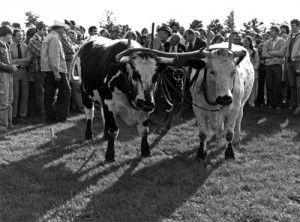
By 1962 the growing college recognized the need for larger facilities. A year later the current 40-acre site at the southeast corner of the Urbana campus, bounded by Lincoln Avenue, Hazelwood Drive, and St. Mary’s Road, was identified for new construction and relocation of the college. In 1971 the Small Animal Clinic and Surgical-Obstetrical Laboratory (now known as the Clinical Skills Learning Center) opened. The Large Animal Clinic was completed in 1976. The college’s first endowed scholarship, the Anna M. Gulick Scholarship, was established in 1964.
State funding for the current Basic Sciences Building—as well as new facilities for the campus’s College of Agriculture—was provided through the Food For Century III initiative, aimed at strengthening the research and educational underpinnings of the food and agricultural industries. When the $24 million facility was dedicated in April 1983, it united the college’s facilities in one location for the first time.
Leadership in Veterinary Research and Teaching
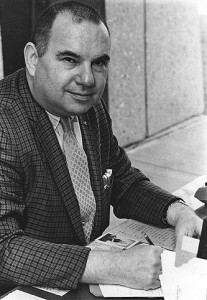
Luminaries in veterinary research and education helped establish a strong reputation for the College of Veterinary Medicine in its early years. Dr. Lloyd Davis pioneered the field of veterinary pharmacology, and Dr. Norman Levine was internationally known for his research on Protozoa and other parasitic organisms that cause diseases, such as malaria and toxoplasmosis, in animals and humans. Dr. Erwin Small, who spent more than 50 years at the college, was a national leader for organized veterinary medicine and the advancement of the profession. Toward the end of the 20th century, Illinois broke ground in pedagogical research into the use of simulations and models to enhance mastery of veterinary clinical skills while conserving animal resources.
With its Center for Zoonosis Research, established in 1960, the college was an early advocate of interdisciplinary research collaborations aimed at improving human and animal health. Both infectious disease and environmental toxicology were prominent areas of research for the college in the second half of the 20th century. In 2004 an NIH grant for facilities renovation expanded and updated biomedical laboratory space in the basic sciences building. With the advent of genomic research and molecular biology, the concept of “one medicine” took on greater meaning: not only are the health and well-being of humans, animals, and the environment intimately linked, but at the most basic levels many biological functions are shared. The College of Veterinary Medicine emerged as strong proponent of translational biomedical research—discoveries at the genomic, molecular, and cellular levels that had applications for improving human and animal health. The college’s two basic sciences departments adopted new names during this period to reflect the fact that they engage in biomedical discovery that is not limited to veterinary applications.
Recent Advances, Future Directions
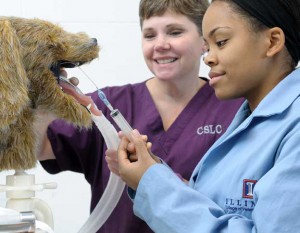
In 2006 the college adopted a bold strategic plan that led to remarkable advancements over the following three years. By 2009, the faculty had conceived and implemented an innovative veterinary curriculum that integrated clinical competency throughout the four-year degree program; had built the nation’s most comprehensive clinical skills learning facility; had established a clinical presence in Chicago to support the teaching and outreach mission of the college; had launched the Center for One Health Illinois; and had successfully met and exceeded its fund-raising goal for the Brilliant Futures campaign, bringing in a total of $51 million.
With its three academic departments—Comparative Biosciences, Pathobiology, and Veterinary Clinical Medicine—and three service units—the Chicago Center for Veterinary Medicine, the Veterinary Diagnostic Laboratory, and the Veterinary Teaching Hospital—Illinois claims many strengths that provide a firm foundation for growth: historic ties to the agricultural industries in the state; location within a world-class university; international recognition for the newly introduced veterinary curriculum and the Clinical Skills Learning Center; research faculty with NIH-funded programs; veterinary specialists who are leaders in their fields; access to the state’s population center; a prominent and supportive alumni and donor base; and expertise that is highly relevant to a host of societal needs, from basic biology to public health, emerging infectious disease, food safety, food productivity, environmental toxicology, specialized medicine, and the human-animal bond.
In charting the college’s future course for addressing the needs of society and advancing veterinary science, the faculty draw on these assets and on their own proven track record of successful innovation.
College Leaders
Dean Graham – 1945-1956
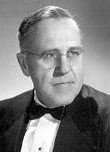 Robert K. Graham came to the University of Illinois in 1917, joining the Department of Animal Husbandry. He pursued his vision for a strong Extension program and diagnostic service to aid the livestock industry and protect public health. He also lobbied tirelessly for the creation of the College of Veterinary Medicine and in 1945, he became its first dean. A Large Animal Clinic was built in 1955, while the Small Animal Clinic continued to operate in a former beef barn. Dean Graham earned a veterinary degree from Iowa State College and a master’s degree from the University of Kentucky. He served in the Veterinary Corps of the U.S. Army from 1917 to 1924 and developed the first antitoxin for botulinus poisoning in man.
Robert K. Graham came to the University of Illinois in 1917, joining the Department of Animal Husbandry. He pursued his vision for a strong Extension program and diagnostic service to aid the livestock industry and protect public health. He also lobbied tirelessly for the creation of the College of Veterinary Medicine and in 1945, he became its first dean. A Large Animal Clinic was built in 1955, while the Small Animal Clinic continued to operate in a former beef barn. Dean Graham earned a veterinary degree from Iowa State College and a master’s degree from the University of Kentucky. He served in the Veterinary Corps of the U.S. Army from 1917 to 1924 and developed the first antitoxin for botulinus poisoning in man.
Dean Brandly – 1956-1968
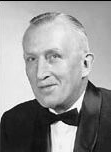 Carl A. Brandly spearheaded the creation of the Center for Zoonoses Research, which was established in 1960. He was credited for his devotion to professional and graduate education. His worldwide service for the veterinary profession was recognized by the American Veterinary Medical Association’s 12th International Congress Prize. Dean Brandly earned a veterinary degree and a master’s degree from Kansas State University. During World War II he served as director of the Huntington War Research Program on Exotic Diseases at Harvard University Medical School.
Carl A. Brandly spearheaded the creation of the Center for Zoonoses Research, which was established in 1960. He was credited for his devotion to professional and graduate education. His worldwide service for the veterinary profession was recognized by the American Veterinary Medical Association’s 12th International Congress Prize. Dean Brandly earned a veterinary degree and a master’s degree from Kansas State University. During World War II he served as director of the Huntington War Research Program on Exotic Diseases at Harvard University Medical School.
Dean Jones – 1968-1976
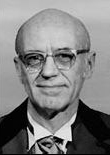 During the tenure of Dean L. Meyer Jones, the two current hospital buildings were built—the Small Animal Clinic in 1971 and the Large Animal Clinic in 1976—and the college began its innovative use of computer-aided instruction with PLATO. Near the end of his deanship the college joined forces with the then-College of Agriculture to promote Food for Century III, a program that sought state dollars to help increase the contributions of the University of Illinois to the state’s food production industry through teaching, research, and Extension programs. Dean Jones received his veterinary and master’s degrees from Iowa State University and a PhD from the University of Minnesota Medical School. He was the author of an internationally known textbook, Veterinary Pharmacology and Therapeutics. Before becoming the dean at Illinois, he had led the School of Veterinary Medicine at the University of Georgia and served for five years as director of scientific activities at the American Veterinary Medical Association.
During the tenure of Dean L. Meyer Jones, the two current hospital buildings were built—the Small Animal Clinic in 1971 and the Large Animal Clinic in 1976—and the college began its innovative use of computer-aided instruction with PLATO. Near the end of his deanship the college joined forces with the then-College of Agriculture to promote Food for Century III, a program that sought state dollars to help increase the contributions of the University of Illinois to the state’s food production industry through teaching, research, and Extension programs. Dean Jones received his veterinary and master’s degrees from Iowa State University and a PhD from the University of Minnesota Medical School. He was the author of an internationally known textbook, Veterinary Pharmacology and Therapeutics. Before becoming the dean at Illinois, he had led the School of Veterinary Medicine at the University of Georgia and served for five years as director of scientific activities at the American Veterinary Medical Association.
Dean Dierks – 1976-1989
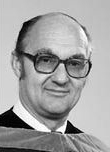 Among the many milestones achieved during the tenure of Dean Richard E. Dierks, the college’s veterinary diagnostic laboratory gained greater prominence within the state diagnostic laboratory system. The Animal Poison Information Center originated as a service program at the college in 1978, and operated here for nearly 20 years before becoming part of the ASPCA. During the 1980s the college awarded 760 DVM degrees, 93 master’s degrees, and 61 PhD degrees. The college’s first endowed graduate student award, the Mariangela and Diego Segre Research Award, was also established then. Dean Dierks earned a DVM, a master’s, and a PhD degree at the University of Minnesota and was considered an expert in microbiology. He was a renowned veterinary statesman who held prominent service leadership positions in organized veterinary medicine and with the US Department of Agriculture.
Among the many milestones achieved during the tenure of Dean Richard E. Dierks, the college’s veterinary diagnostic laboratory gained greater prominence within the state diagnostic laboratory system. The Animal Poison Information Center originated as a service program at the college in 1978, and operated here for nearly 20 years before becoming part of the ASPCA. During the 1980s the college awarded 760 DVM degrees, 93 master’s degrees, and 61 PhD degrees. The college’s first endowed graduate student award, the Mariangela and Diego Segre Research Award, was also established then. Dean Dierks earned a DVM, a master’s, and a PhD degree at the University of Minnesota and was considered an expert in microbiology. He was a renowned veterinary statesman who held prominent service leadership positions in organized veterinary medicine and with the US Department of Agriculture.
Dean Valli – 1990-2001
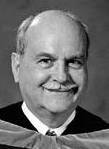 Under Dean Victor E.O. “Ted” Valli’s leadership, the college benefited from nearly $6 million in state funding through a new Venture Technology program. Both the Medical Scholars joint degree program and the clinical medicine PhD degree were established. In 1996 the veterinary class size was increased to 100 students. By the late 1990s, the rising proportion of women veterinary students stabilized at about 75 percent. Dean Valli fostered strong connections with the professional students by hosting welcome and graduation events in his home and by lecturing in histology. In 1995, the college’s first class endowment was created by the Class of 1962 to support a speaker at the Annual Fall Conference for Veterinarians. Dean Valli received a DVM degree from the University of Toronto as well as master’s and PhD degrees from Ontario Veterinary College, where he also chaired the Department of Pathology and served as associate dean of research before coming to Illinois. He served in the South Alberta Regiment from 1945 to 1954.
Under Dean Victor E.O. “Ted” Valli’s leadership, the college benefited from nearly $6 million in state funding through a new Venture Technology program. Both the Medical Scholars joint degree program and the clinical medicine PhD degree were established. In 1996 the veterinary class size was increased to 100 students. By the late 1990s, the rising proportion of women veterinary students stabilized at about 75 percent. Dean Valli fostered strong connections with the professional students by hosting welcome and graduation events in his home and by lecturing in histology. In 1995, the college’s first class endowment was created by the Class of 1962 to support a speaker at the Annual Fall Conference for Veterinarians. Dean Valli received a DVM degree from the University of Toronto as well as master’s and PhD degrees from Ontario Veterinary College, where he also chaired the Department of Pathology and served as associate dean of research before coming to Illinois. He served in the South Alberta Regiment from 1945 to 1954.
Dean Whiteley – 2001-2013
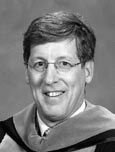 Dean Herbert E. Whiteley led the college through a period of tremendous innovation despite budgetary constraints. During his tenure the college introduced the Illinois model of veterinary education, which greatly expanded students’ clinical exposure and hands-on experiences while integrating basic science education to emphasize clinical relevance. The Chicago Center for Veterinary Medicine was established to expand the college’s reach in clinical service and student recruiting. Dean Whiteley led a campus initiative to foster multidisciplinary collaborations in translational biomedical research—translating discoveries in the basic sciences into relevant medical applications. The college gained its first endowed chair and increased the number of scholarship endowments and class endowments under Dean Whiteley. Dean Whiteley earned a veterinary degree from Purdue University and a PhD from Colorado State University. He is board certified by the American College of Veterinary Pathology, with an emphasis in ocular disease. After serving on the faculty at Illinois for more than 10 years, he spent six years heading the Department of Pathobiology and Veterinary Science at the University of Connecticut and the Connecticut Veterinary Diagnostic Laboratory before returning to Illinois as dean.
Dean Herbert E. Whiteley led the college through a period of tremendous innovation despite budgetary constraints. During his tenure the college introduced the Illinois model of veterinary education, which greatly expanded students’ clinical exposure and hands-on experiences while integrating basic science education to emphasize clinical relevance. The Chicago Center for Veterinary Medicine was established to expand the college’s reach in clinical service and student recruiting. Dean Whiteley led a campus initiative to foster multidisciplinary collaborations in translational biomedical research—translating discoveries in the basic sciences into relevant medical applications. The college gained its first endowed chair and increased the number of scholarship endowments and class endowments under Dean Whiteley. Dean Whiteley earned a veterinary degree from Purdue University and a PhD from Colorado State University. He is board certified by the American College of Veterinary Pathology, with an emphasis in ocular disease. After serving on the faculty at Illinois for more than 10 years, he spent six years heading the Department of Pathobiology and Veterinary Science at the University of Connecticut and the Connecticut Veterinary Diagnostic Laboratory before returning to Illinois as dean.
Dean Constable – 2014 –
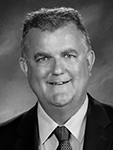 Dean Peter D. Constable took the helm with a focus on expanding the college’s leadership in innovative veterinary education, excellent patient care, and vital biomedical research. He began his academic career at Illinois in 1993 as an assistant professor in the Department of Veterinary Clinical Medicine, and returned as dean after having served as head of the veterinary clinical sciences department at Purdue University from 2006 to 2013. Dean Constable earned his veterinary degree from the University of Melbourne, Australia, and practiced in Australia and England before joining The Ohio State University for an ambulatory internship and a food animal medicine and surgery residency, as well as master’s and doctoral degrees in cardiovascular physiology. He is board certified by the American College of Veterinary Internal Medicine and the American College of Veterinary Nutrition and is widely published. He is a coauthor of the tenth edition of Veterinary Medicine: A Textbook of the Diseases of Cattle, Horses, Sheep, Pigs, and Goats.
Dean Peter D. Constable took the helm with a focus on expanding the college’s leadership in innovative veterinary education, excellent patient care, and vital biomedical research. He began his academic career at Illinois in 1993 as an assistant professor in the Department of Veterinary Clinical Medicine, and returned as dean after having served as head of the veterinary clinical sciences department at Purdue University from 2006 to 2013. Dean Constable earned his veterinary degree from the University of Melbourne, Australia, and practiced in Australia and England before joining The Ohio State University for an ambulatory internship and a food animal medicine and surgery residency, as well as master’s and doctoral degrees in cardiovascular physiology. He is board certified by the American College of Veterinary Internal Medicine and the American College of Veterinary Nutrition and is widely published. He is a coauthor of the tenth edition of Veterinary Medicine: A Textbook of the Diseases of Cattle, Horses, Sheep, Pigs, and Goats.
College Milestones
1940s to 1960s
- 1948 The new University of Illinois College of Veterinary Medicine enrolled its first Doctor of Veterinary Medicine degree class, comprised of 24 veterans of World War II.
- 1948 Dr. Norman D. Levine, known as the “Father of Modern Protozoology,” joined the veterinary faculty when the college was established in 1948, and continued scholarly productivity many years after receiving emeritus status in 1983. He was an internationally respected authority on parasitology and on the taxonomy of the protozoa. Among his many books are the two-volume The Protozoan Phylum Apicomplexa (he had named this phylum) and the text Veterinary Protozoology, which was first issued in 1961 and revised in 1973 and 1985.
- 1962 Dr. John Thurmon joined the Illinois faculty and, in 1975, helped establish the American College of Veterinary Anesthesiologists. In conjunction with Drs. William Tranquilli and John Benson, Illinois provided leadership in advancing veterinary anesthesia, particularly injectable anesthesia and analgesia, including the development of “triple drip” anesthesia for large animals.
1970s to 1980s
- 1970 The college adopted the first computer-assisted instructional program in the world, called PLATO (Programmed Logic for Automatic Teaching Operations), which was developed on the Urbana campus in the 1960s. Within four years, nearly 400 hours of instructional material drawn from throughout the veterinary curriculum were made available through PLATO. The college remains a pioneer in the use of emerging educational technologies.
- 1972 Dr. Lloyd Davis and colleagues published a seminal paper in veterinary pharmacology on “species differences in transformation and excretion of salicylate,” that demonstrated for the first time that dose regimens cannot be extrapolated from one species to another, a common practice prior to that time.
- 1978 Dr. William Buck and his graduate students established the first animal-oriented poison hot line, answering calls around-the-clock using a paging service and tapping into their extensive database of information specific to animal poisoning. The National Animal Poison Control Center operated at the College of Veterinary Medicine from 1978 to 1996, when it was transferred to the ASPCA.
- 1979 Dr. Robert Twardock pioneered the field of equine nuclear medicine, developing non-invasive techniques for diagnosis of equine lameness and lung problems that had gone otherwise undetected by conventional diagnostic techniques.
- 1980s Dr. Ann Johnson and colleagues pioneered the use of models to teach surgical skills to veterinary students. This work paved the way for the establishment of the college’s comprehensive Clinical Skills Learning Center in 2009.
1990s
- 1991 Dr. Wanda Haschek-Hock coauthored the first edition of Haschek and Rousseaux’s Handbook of Toxicologic Pathology. The single-volume first edition became the definitive text in the field and was replaced in 2002 with a two-volume second edition and in 2013 with a three-volume third edition; Dr. Matthew Wallig, also on the Illinois faculty, was a coauthor on the second and third editions.
- 1991 An era of equine sports medicine research was launched with the acquisition of a horse treadmill capable of carrying a horse galloping at 30 miles per hour. Dr. Jonathan Foreman’s work on exercising horses in heat and humidity influenced the monitoring of equestrian sports at the 1996 Atlanta Olympics 1996, and Drs. Thomas Goetz and Murli Manohar elucidated the mechanisms and drugs used to treat exercise-induced pulmonary hemorrhage, which affects up to 90% of racing Thoroughbred horses.
- 1991 Under the leadership of Dr. LeRoy Biehl, Illinois introduced the Executive Veterinary Program in Swine Health Management, a two-year certificate program focused on business, communication and strategic planning skills; over the following 23 years, more than 200 top swine veterinarians and producers, including many representing the world’s largest pork companies, participated in this award-winning program.
- 1993 The college’s Zoological Pathology Program was founded as a two-person service that provided comprehensive diagnostic services to institutions in the Chicago area. It has grown to a six-person service that works with federal wildlife agencies, zoos, and conservation organizations on three continents and has an international reputation for excellence in diagnostic service, scholarship, and education of residents and veterinary students.
2000s
- 2001 Dr. Susan Schantz established the FRIENDS Children’s Environmental Health Center, funded by EPA and NIEHS, to investigate the interactive effects of PCBs and methyl mercury (MeHg) on neurodevelopment; in 2013 she received full funding for a second Children’s Environmental Health Center, to study effects of plastics chemicals on human development.
- 2005 Dr. Indrani Bagchi develops and in 2006 applies for a patent for Ulipristal, an emergency contraceptive using endothelin receptor antagonists. In 2012 she became the second faculty member, after Dr. Paul Cooke, to hold the college’s endowed Field Chair in Reproductive Biology.
- 2008 Dr. Val Beasley, who for decades investigated causes of worldwide declines amphibian species, coauthored an article in Nature reporting on the impact of agrochemicals in increasing trematode infections in amphibians.
- 2009 The College of Veterinary Medicine introduced an innovative integrated curriculum that added 24 weeks of clinical rotations in the first three years of the program and tested students with written and clinical “milestone examinations” at two points in their studies.
- 2009 The College of Veterinary Medicine opened the Chicago Center for Veterinary Medicine, its headquarters for clinical service, education, and recruitment in the state’s urban center. In 2016, Veterinary Behavior at Illinois began offering consultations for pet owners in Chicago.
2010s
- 2013 Drs. Susan Schantz and Jodi Flaws receive full funding for a new Children’s Environmental Health and Disease Prevention Research Center, this one to investigate the health effects of exposure to chemicals widely used in plastics.
- 2015 An anticancer agent called PAC-1 entered phase I clinical trials in humans. PAC-1 was developed by Illinois chemistry professor Paul Hergenrother and shown to be effective in treating spontaneously occurring cancers in pet dogs through collaborative research with Dr. Tim Fan.
- 2015 Drs. Brian Aldridge and Jim Lowe launched the college’s first MOOC (massive, open online course), delivering problem-solving skills needed in sustainable food production to thousands of students worldwide.
- 2015 A new mobile surgical unit, funded through a grant from PetSmart Charities, enabled the college’s shelter medicine program to increase the scope and volume of spay and neuter surgeries students perform in underserved areas.
- 2016 The college acquired a 3-Tesla magnetic resonance imaging unit to support its growing neurology, cardiology, and equine services.
- 2017 The college began delivering an Executive Veterinary Program tailored to beef veterinarians in Olathe, Kan., in conjunction with Kansas State University.
- 2019 A state-of-the-art linear accelerator and a new 128-slice CT to support its use made possible a new dimension of cancer treatment for animal patients and new research collaborations.
2020s
- 2020 The Veterinary Medicine South Clinic opened to deliver dog and cat primary care as well as full-service care for zoological companion animals. The building, directly south of the college’s teaching hospital, already housed the Wildlife Medical Clinic, which occupied its first purpose-built space in 2018.
- 2020 In response to the global pandemic, the University of Illinois developed the SHIELD testing program to protect the campus community. College researchers helped devise the novel saliva-based test, while the Veterinary Diagnostic Laboratory rapidly expanded to process the tests and deliver mostly same-day results. Well over 2 million COVID-19 tests were performed by the lab between August 2020 and May 2021.
- 2021 A two-year, $13M renovation of the Veterinary Teaching Hospital, including construction of a 9,000 sq ft small animal surgery wing with seven operating rooms and an interventional radiology suite, was completed.
